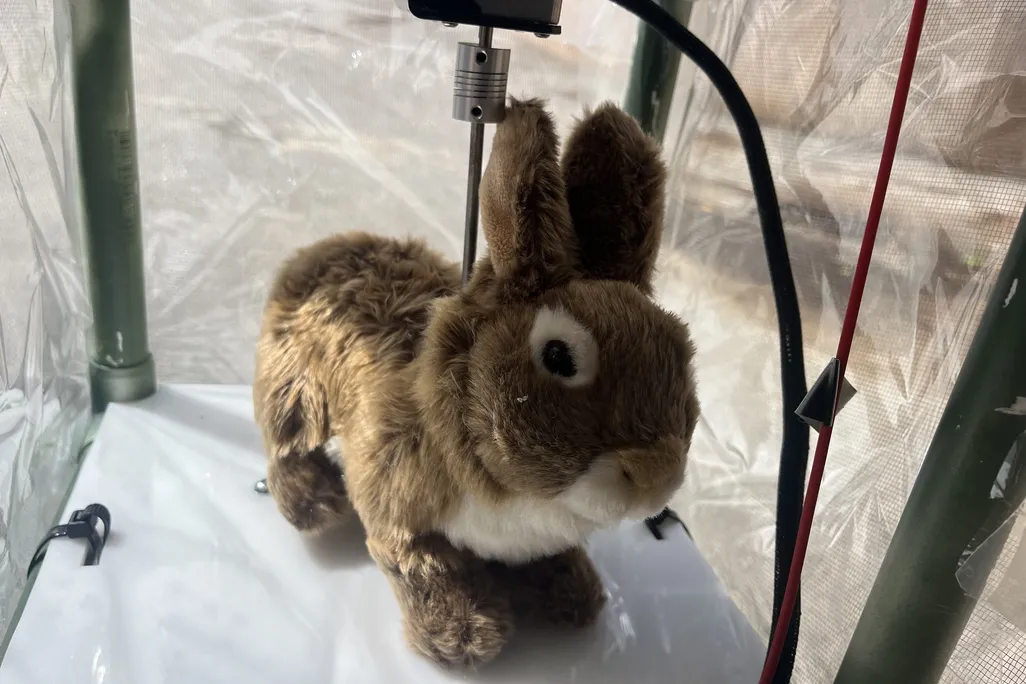‘Robo-Bunnies’ Are the Newest Weapon in the Fight Against Invasive Burmese Pythons in Florida
Scientists are experimenting with robotic rabbits in hopes of luring the destructive snakes out of hiding so they can be euthanized

Wildlife biologists in Florida are doing everything they can to eradicate invasive Burmese pythons, from hosting public hunting challenges and hiring bounty hunters to affixing tracking devices to male “scout” snakes that can lead them to large, reproductive females.
Now, they’ve come up with an innovative new tool to help battle the destructive snakes: robotic rabbits.
Scientists at the University of Florida are deploying the so-called “robo-bunnies” throughout South Florida in hopes of drawing Burmese pythons out of their hiding places so they can be euthanized, reports Kimberly Miller for the Palm Beach Post. By luring the pythons to the rabbit look-alikes, biologists can save time that might otherwise be spent searching through the swamp for the snakes.
The animatronic rabbits are outfitted with motors and internal heaters that are designed to replicate the behaviors and body temperatures of live marsh rabbits (Sylvilagus palustris), which Burmese pythons love to eat.
The South Florida Water Management District is funding the robotic rabbit experiment, and the Florida Fish and Wildlife Conservation Commission has paid for related research in the past.
“Our partners have allowed us to trial these things that may sound a little crazy,” says Robert McCleery, a wildlife ecologist at the University of Florida who’s leading the rabbit project, to the Palm Beach Post. “Working in the Everglades for ten years, you get tired of documenting the problem. You want to address it.”
Did you know? Burmese pythons can swallow enormous prey whole
Because of extra-stretchy connective tissue between their jaw bones, Burmese pythons can open their mouths wide to swallow prey—even deer and alligators—whole. A fall 2024 study found a python that could open its jaws to 10.2 inches in diameter, an inch and a half wider than previously thought.
In the past, researchers have experimented with placing live rabbits in pens in a bid to attract the invasive serpents in Everglades National Park. The live rabbits were indeed effective at luring the snakes, drawing in about one per week, but caring for and managing the small mammals was labor-intensive. Researchers wondered if robotic rabbits might do the job just as well.
/https://tf-cmsv2-smithsonianmag-media.s3.amazonaws.com/filer_public/4f/9a/4f9aa912-cc59-4215-bf9c-9245e1bc580f/image_7.jpeg)
To find out, McCleery and his colleague Chris Dutton gathered 40 toy rabbits and replaced their stuffing with electrical components that run on solar power. They also waterproofed the bunnies so they could withstand South Florida’s rain and humidity. Earlier this month, scientists placed the rabbits at various undisclosed locations for a pilot study to see whether they could fool the snakes.
“If we can see a statistically significant number of pythons that are coming to investigate these robotic rabbits and the pens, that would be a success, because right now, pythons do a great job of staying hidden,” says Mike Kirkland, lead invasive animal biologist for the South Florida Water Management District, to WINK-TV’s Bridget Bruchalski.
The remotely controlled decoys are accompanied by tiny cameras that have been programmed to recognize movement. When a python (or some other snake) slithers by, the camera sends out a notification, which prompts researchers to tune into the video feed to see what kind of snake is approaching.
“If that python is detected, then it contacts someone like myself, who’s available 24 hours a day, and then I can deploy one of our many contractors to go remove it,” Kirkland tells WINK-TV.
If the initial experiment fails to attract pythons, the scientists plan to run a second round of tests with realistic rabbit scents added to the mechanical creatures.
“We want to capture all of the processes that an actual rabbit would give off,” McCleery tells the Palm Beach Post.
/https://tf-cmsv2-smithsonianmag-media.s3.amazonaws.com/filer_public/67/52/675202f6-6afa-4114-8fbe-abd7568532c0/image_8.jpg)
Burmese pythons are native to Southeast Asia but began arriving in the United States in the 1990s and early 2000s as part of the exotic pet trade. At some point, these pet snakes either escaped or were released into the wild, where they quickly adapted to life in Florida.
With few natural predators keeping them in check, the snakes have been proliferating in the Everglades—and the region’s rabbits, foxes, opossums and raccoons have had to pay the price. A 2015 study found Burmese pythons were responsible for 77 percent of rabbit deaths in Everglades National Park.
Experts say it will probably be impossible to fully eradicate Burmese pythons from Florida. But in the meantime, conservationists and biologists are doing their best to make a dent in the population.
The annual Florida Python Challenge, for instance, invites members of the public to kill and remove as many Burmese pythons as possible over a ten-day period for a chance at winning $10,000. This year’s event wrapped up on July 20.
Hunters on private land are always allowed to humanely euthanize the snakes without a permit, so long as they have the landowner’s permission. They can also humanely kill Burmese pythons on specific public lands managed by the Florida Fish and Wildlife Conservation Commission. Anyone who sees a Burmese python is encouraged to call the Florida Fish and Wildlife Conservation Commission’s exotic species hotline.
The South Florida Water Management District and the Florida Fish and Wildlife Conservation Commission have also deployed python bounty hunters, who have removed nearly 16,000 of the snakes since 2019, per the Palm Beach Post.
/https://tf-cmsv2-smithsonianmag-media.s3.amazonaws.com/accounts/headshot/SarahKuta.png)
